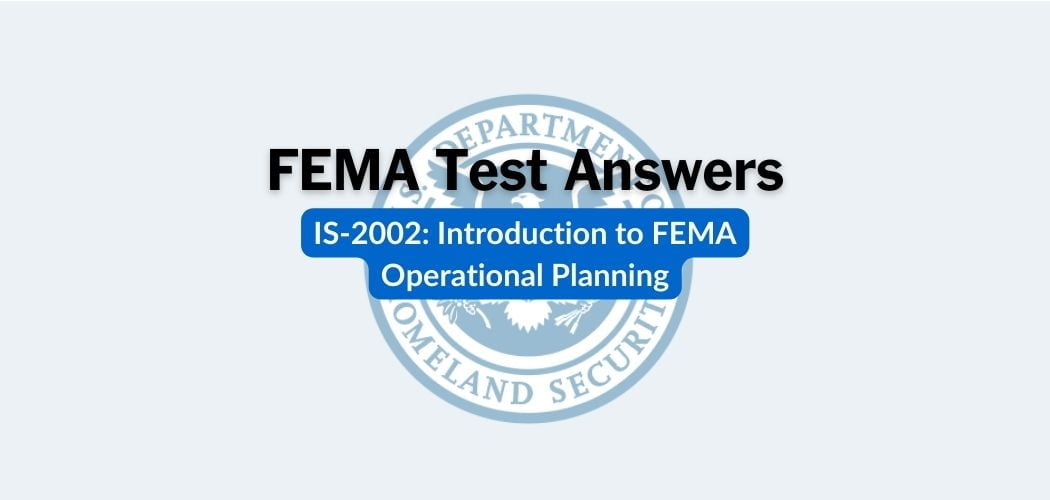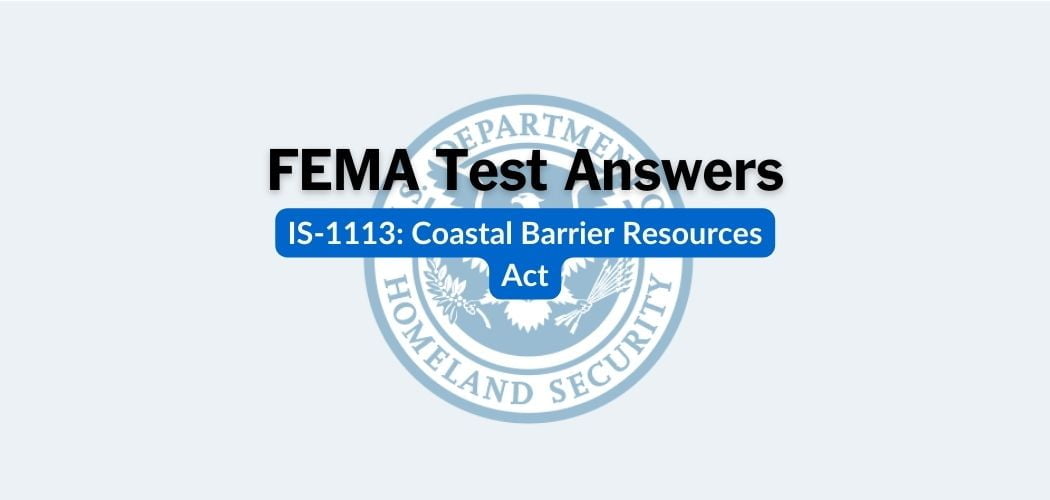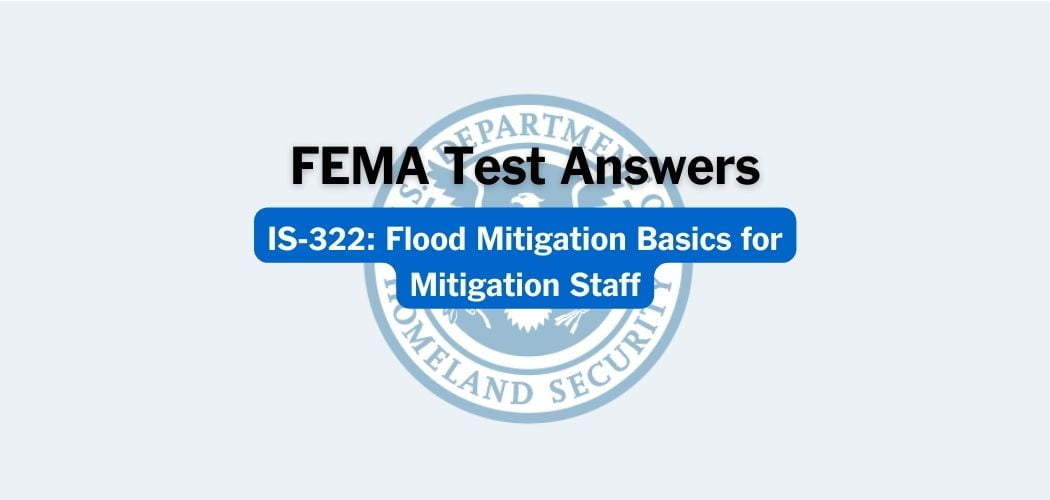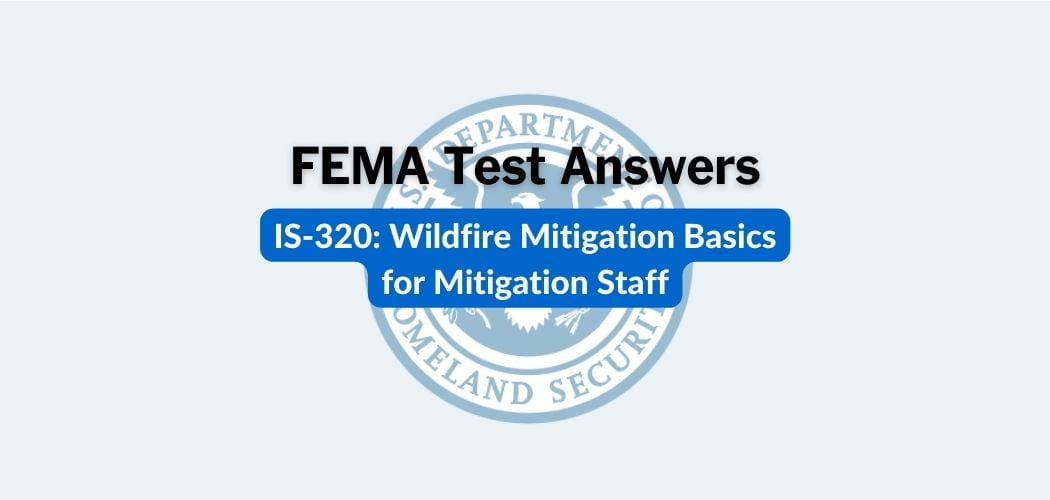Overview: The FEMA IS-545.A course was updated on 2/13/2024 to learn to design and implement a reconstitution plan. You will become proficient in how reconstitution planning ensures positive outcomes. As the final phase of continuity, reconstitution is an integral part of your organization’s continuity plan.
FEMA IS-545.A addresses each part of a reconstitution plan and explores best practices to implement your plan so you can make a meaningful contribution to your organization’s efforts to recover from any disaster and become competent in the complexities of reconstitution planning.
Primary audience: The FEMA IS-545.A is open to Federal, State, local, tribal, and territorial government employees responsible for COOP and reconstitution planning.
FEMA IS-545.A test answers
Note: Each time this test is loaded, you will receive a unique set of questions and answers. The test questions are scrambled to protect the integrity of the exam.
Question 1. Identify from the following list, which element should be addressed in a reconstitution plan.
A. Recreation
B. People
C. Uniforms
D. Personal vehicles
Question 2. Each of the following are primary goals of the Reconstitution Implementation Team EXCEPT for.
A. Communicate the Post-event plan
B. Assess the actual situation
C. Implement the Post-event Plan
D. Implement the unrefined pre-event plan
Question 3. Identifying security challenges that should be addressed in reconstitution plans that is used to protect sensitive elements of your operations and reconstitution operations.
A. Operations Security (OPSEC)
B. Application Security (APPSEC)
C. Personnel Security (PERSEC)
D. Health Insurance Portability and Accountability Act (HIPAA)
Question 4. All of the following are roles of a Reconstitution Manager EXCEPT:
A. Be senior enough to work directly with senior leadership
B. Have a close working relationship with the continuity manager but not be the continuity manager;
C. Serves on the Continuity Team following a continuity event.
D. Be able to lead the reconstitution teams and is familiar with the reconstitution plan.
Question 5. Which phase of reconstitution incorporates a priority-based approach to returning to normal operation?
A. Phase B, Event Planning
B. Phase A, Event Preparedness
C. Phase C, Implementation of Operations
D. Phase 4, End of Reconstitution
Question 6. Identify one of the major topics that should be addressed in Chapter 5 of a reconstitution plan.
A. Public Assistance Management Costs
B. After Action Activities
C. Implementation of the plan
D. Mission assignments
Question 7. Describe one of the day-to-day roles of the reconstitution team leader.
A. Sends messages to the organization regarding the organization’s status in returning to normal operations.
B. Selects members of the reconstitution team.
C. Manages the work of the planning teams.
D. Develops post-event records management guidance for the organization.
Question 8. Which of the following is a federal requirement and non-federal suggestion to include in a post-event reconstitution implementation plan?
A. Develop options for the repair or replacement of damaged facilities
B. Pre-event preparedness training for an all-hazards reconstitution plan
C. Addressing organizational vehicle resource disruptions resulting from the event
D. Ensuring facilities adhere to OSHA requirements before an event happens.
Question 9. Identify one detailed organizational-based reconstitution planning requirement that can speed up the repair of a facility.
A. Organizational safety plans
B. Leasing a temporary facility
C. Locations of blueprints of the facility.
D. A list of who will occupy the repaired facility.
Question 10. Identify the most significant difference in how federal and non-federal organizations define reconstitution.
A. Non-federal organizations do not have an “End of Reconstitution Operations” sub-phase of reconstitution.
B. There is no difference in how federal and non-federal define reconstitution.
C. Federal government defines reconstitution as an end state rather than a process.
D. Non-federal levels of government define reconstitution as an end state rather than a process.
Question 11. Fill in the blank. The reconstitution team leader manages the work of the planning teams and completes tasks as required by the _____.
A. Reconstitution Manager
B. Continuity Manager
C. Continuity POC
D. Senior Safety Manager
Question 12. Identify the statement that most comprehensively describes a focus of reconstitution plans.
A. Continuity plans focus on the possible continuance of essential functions.
B. Reconstitution plans are focused exclusively on the resumption of essential functions.
C. Reconstitution plans focus on the resumption of deferred and discontinued functions.
D. Devolution plans focus on the relocation of essential functions.
Question 13. The characteristics of the reconstitution team members include all of the following EXCEPT:
A. Focused on a common goal
B. Cannot work independently
C. Technical expertise
D. Strong communication skills
Question 14. Identify the word that completes the definition of reconstitution. Reconstitution is the process by which surviving and / or replacement personnel resume _____ operations.
A. normal
B. unique
C. essential
D. rewarding
Question 15. Select the answer that best completes the following sentence. The ___ of the reconstitution team members include technical expertise; strong communication skills; ability to work independently or as a team member; and the ability to focus on a common goal.
A. concept
B. training
C. focus
D. characteristics
Question 16. Complete the following statement with the best possible statement. Planning for the logistics element of a reconstitution plan will be ____.
A. unnecessary
B. critical
C. a secondary consideration
D. a job for continuity planners
Question 17. Select the element, which if lost, would not cause an organization to have to reconstitute.
A. Personnel
B. Facilities
C. Records
D. Delegation of Authority plans
Question 18. Select the word that most accurately completes the sentence. The reconstitution implementation plan should address an effective transition or recovery of ____.
A. essential records
B. Milestones
C. continuity communications
D. TT&E programs
Question 19. Identify the example of a situation that could cause reconstitution to be necessary without having a declared continuity event.
A. Pandemic
B. Terrorist Attack
C. Hurricane
D. Earthquake
Question 20. Each of the following is among the primary goals of the pre-event Reconstitution Planning Team except?
A. To develop a plan that can be trained and exercised throughout the organization.
B. To build a realistic plan that the organization accepts and Leadership approves.
C. To establish Post-event reconstitution milestones.
D. To develop a pre-event plan that provides a reasonable and useful starting point for post-event tailoring to a potential actual disruption.
Question 21. Identify one of the roles of an organizational Reconstitution Manager.
A. Communicates the status of reconstitution efforts with the organization’s senior leadership following a disruptive event.
B. Serves as the organization’s Continuity Manager
C. A subject matter expert in the fields of HR and records management
D. A mid-level manager who manages the day-to-day operations of an organization’s reconstitution program.
Question 22. Fill in the blank. Damaged organizational ____ equipment can compound other challenges to reconstitution.
A. IT
B. Telephone
C. Air filtration
D. cafeteria
Question 23. Identify the role of a pre-event Reconstitution Planning Team.
A. Implements COOP plans.
B. Prepares the reconstitution plan
C. Activates devolution team
D. Ensures continuance of essential functions
Question 24. Specific instructions to personnel on how to return to normal operations following a specific continuity event is a requirement for which type of reconstitution plan.
A. Post-event implementation plan
B. Pre-event plan
C. neither a pre-event or post event plan
D. COOP facility management plan
Question 25. Fill in the blank. FCD-1 directs that each executive branch department or agency shall develop continuity plans, including _ and devolution.
A. critical information
B. essential functions
C. reconstitution
D. transportation
Question 26. Identify a personnel issue that may need to be addressed prior to staff returning to work.
A. Damage to a facility
B. Pay
C. Transportation
D. IT equipment
Question 27. Each of the following could cause communication challenges following an event that could be mitigated or reduced by addressing the challenge within your plan EXCEPT:
A. Having a detailed security plan and risk assessment completed for any new facilities.
B. Ensuring phones and support are available
C. Having a detailed inventory of the equipment that existed before the event.
D. Keeping staff and external stakeholders informed.
Question 28. Identify the level of government that the definition of reconstitution applies to.
A. non-federal only
B. Federal only
C. Both federal and non-federal
D. neither federal nor non-federal
Question 29. Select the word that most accurately completes the following sentence. The elements of reconstitution are established in part through ____ for reconstitution programs as established in FCD-1.
A. guidelines
B. requirements
C. records
D. common errors
Question 30. Reconstitution training should be conducted at a minimum?
A. Every other year
B. Annually
C. Quarterly
D. Every three years
Question 31. If a continuity event damages records (i.e., chemicals, radiation, severe mold,) to the point that they have become a menace to human health, life, or to property, what are your options for destroying said records?
A. Controlled burn when authorized by a fire permit.
B. Obtain specific approval from NARA or a non-federal equivalent to eliminate the menace and then continue with destruction.
C. Upon order of the organization Reconstitution Team Leader, destroy them by burying or pulverization.
D. Upon order of the organization’s safety director, destroy them by burying or pulverization.
Question 32. Identify the common activity that both continuity and reconstitution planners scope their plans for.
A. Performance of essential functions
B. Performance of functions that were disrupted by a catestrophic event
C. Performance of functions
D. Performance of reconstitution operations
Question 33. Identify the word that completes the definition of reconstitution. Reconstitution is the process by which surviving and / or replacement ____ resume normal operations.
A. personnel
B. equipment
C. governments
D. facilities
Question 34. Select the most correct answer from the material provided in this course that finishes the following statement. An option for temporary leased space is:
A. Arrangements for temporary space through your leasing authority
B. Other facilities that the organization already controls or manages
C. working outdoors near the damaged facility
D. purchasing a new permanent facility
Question 35. Identify a characteristic that members of a reconstitution planning team should have.
A. Works best alone
B. Strong communication skills
C. Communicates effectively while supervised
D. Volunteered to be on the team
Question 36. Identify a personnel issue that can create challenges to reconstitution.
A. Employees teleworking
B. Hiring and onboarding new employees
C. Damage to a facility
D. Shortages in IT equipment
Question 37. Select the answer that best completes the following sentence. The success of your reconstitution planning may depend on the ____ of the reconstitution planning team.
A. funding
B. membership
C. communications requirements
D. security
Question 38. Identify the word that completes the following statement.Sites will synch with the reconstitution planning of ____.
A. records
B. personnel
C. facilities
D. legal
Question 39. In what way does determining the organization’s reconstitution status following an event, impact the reconstitution planning process?
A. Determines how long it will take to resume normal operations
B. Determines the organization’s readiness
C. Determines the speed of recovery of the local economy
D. Determines why reconstitution can occur
Question 40. Identify the level of government that MAY NOT treat the federal requirements for reconstitution as guidelines.
A. State
B. Federal only
C. Tribal
D. Territorial
Question 41. Identify the item that has not been identified as a way to mitigate communication / messaging requirements that should be included in reconstitution plans.
A. The type of information to be communicated.
B. The specific person (by position or title) who will send the messages.
C. The modes of communication that will be used.
D. The location of archives of organizational expenditure records.
Question 42. Identify the federal directive that outlines the requirements for the federal department and agency’s reconstitution plans.
A. FCD-2
B. FCD-1
C. FCD-3
D. FCD-4
Question 43. Security is a significant element of reconstitution planning and must be addressed in both reconstitution plans. A security professional should be a ____ member of the reconstitution team.
A. Permanent
B. Temporary
C. Non-existent
D. As needed
Question 44. Describe a role that the reconstitution team leader has in selection of reconstitution team members.
A. Provides input to the Reconstitution Team Manager on the selection of personnel
B. Roles designated by the Reconstitution Manager
C. Is the final decision maker for the selection of personnel to the reconstitution team.
D. Recruits members from the ERG who are involved in the performance of essential functions to be members of the reconstitution team.
Question 45. Identify one of the major topics that should be addressed in Chapter 1 of a reconstitution plan. Select the most correct answer.
A. Applicability and Scope
B. Purpose of the plan
C. Roles and Responsibilities
D. Pre-event preparedness
Question 46. Fill in the blank. Reconstitution pre-event planning is ____ process of developing a plan for an organization to use to return to normal operations following a disruption.
A. Unintentional
B. Deliberate
C. Haphazard
D. Orderly
Question 47. Which of the following is NOT an element of reconstitution?
A. Facilities
B. Personnel
C. Records
D. Morale Activities
Question 48. Which of the follow characteristics is least important for an effective Reconstitution Team Manager?
A. Effective management and negotiation skills
B. Effective leadership skills
C. Extensive knowledge of building repair requirements
D. Good working relationship with the Continuity Manager



